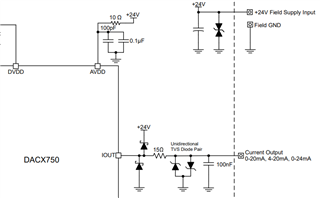Other Parts Discussed in Thread: DAC8750, DAC8775, DAC8771
Case one, DAC7750 load 0~1K ohms change, with a multimeter current gear parallel at both ends of the load, DAC7750 is easy to be damaged;
Case two: The power supply has the function of hot swap, and DAC7750 in the charged board card has been damaged in the process of inserting tightly;
The principle diagram is as follows, whether the design problem causes easy damage, and whether the CIRCUIT CAP1&CAP2 is related to the slew rate. At present, this part is not designed.



